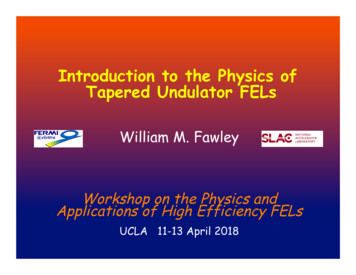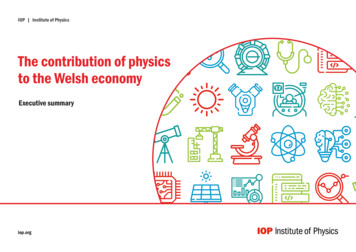
Transcription
Introduction to the Physics ofTapered Undulator FELsWilliam M. FawleyWorkshop on the Physics andApplications of High Efficiency FELsUCLA 11-13 April 2018
Outline What is undulator tapering and why it is important Brief review of basic 1982 KMR theory and suggestions Summary of particular tapered FEL experiments The recent rebirth of high gain, amplifier taper physics- experimental tapering returns: both SASE and seeded- theoretical optimization for TW-FELs Some detrapping concerns Best strategy for tapering self-seeded FELs? Desire for a well-diagnosed, well-benchmarked, shortwavelength deep taper FEL expt.WM Fawley --- Tapered Undulator Physics ---- UCLA Workshop on Physics and Applications of High Efficiency FELS --- 11-13 April 2018
What is Undulator Tapering Undulators are characterized by their polarization (e.g., linearor circular), wavelength λu, and normalized undulator strengthK or auFor a electron beam particle to be in exact resonance withthe radiation waveλuλ s 2 (1 a u2 γ 2 β 2 )2γ Tapering involves systematically changing either K or (inprinciple at least) λu to account for electron energy lossTapering has been studied theoretically and experimentallyfor nearly 4 decadesWM Fawley --- Tapered Undulator Physics ---- UCLA Workshop on Physics and Applications of High Efficiency FELS --- 11-13 April 2018
Why Taper? Energy extraction efficiency --- defeat the smallness of ρ- Std. result at saturation:PRAD 1.6 ρ PBEAM- XUV & X-ray wavelength region:ρ 10-3-For 3X or greater power increase, 50% undulator extensionis cheap!!! (relative to total facility cost) Some other good reasons (but not covered here):– Reduction of spectral sideband contamination– Production of very intense, ultrashort pulses (e.g., XLEAP)– Reverse taper to change power/bunching ratio upstreamof circularly-polarized “afterburner”– IFEL accelerationWM Fawley --- Tapered Undulator Physics ---- UCLA Workshop on Physics and Applications of High Efficiency FELS --- 11-13 April 2018
KMR Trapped Particle & Tapering Theorythe urtext for FEL tapering physics WM Fawley --- Tapered Undulator Physics ---- UCLA Workshop on Physics and Applications of High Efficiency FELS --- 11-13 April 2018
KMR Theory --- Decelerating Buckets Hamiltonian analysis stimulated by analogy of FEL ponderomotive wells toRF acceleration buckets in linacs (P. Morton)Electrons could be both trapped and then stably decelerated via reducing K(ignoring effects of diffraction, betatron motion, spontaneous emission, etc. )Standard FEL longitudinal equations:To keep a resonant “design” electron at constant ψR ,balance gamma loss by reduction in aw ( KRMS);eikonal phase derivative can be important10.9Norm. Bucket AreaNorm. Deceleration Power0.80.7KMR often remembered for a constant ψR (z) approachResultant bucket area is a strong function of ψRmax (sin ψR area) 0.17@ ψR 0.430.60.50.40.30.20.1000.5PSI R (rad)1WM Fawley --- Tapered Undulator Physics ---- UCLA Workshop on Physics and Applications of High Efficiency FELS --- 11-13 April 20181.5
KMR Theory - Variable ΨR ? KMR were no dummies – they knew ψR could be varied: “Fine-tuning” ΨR and K in saturation region can improvetrapping --- this is now well-appreciated by many workers FRED/GINGER “self-design" algorithm (mid-1980’s):ΨR ΨR0 g (z – z0) for z0 z zM ,then constant with z ;z0 typically zsat – 2LG Many FEL codes including GENESIS, FAST, etc., allow oneto pre-specify a given K(z)WM Fawley --- Tapered Undulator Physics ---- UCLA Workshop on Physics and Applications of High Efficiency FELS --- 11-13 April 2018
1984-6 ELF Expts. @ Livermore Joint LBNL – LLNL experiment to study physics ofhigh gain, high energy extraction FELs Initial expt. @ 35 GHz (8 mm) in over-moded waveguideseeded with low power ( 50 kW; PSAT 100 MW) magnetron Findings included:– importance of good matching to undulator transport– high gain and saturation for untapered undulator– confirmation of “launching losses” (factor of 1/9 in power coupling)– SASE studies: expt. stimulated K-J Kim classic SASE paper– very high energy extraction efficiency ( 35%) for tapered undulator(starting with P PSAT)WM Fawley --- Tapered Undulator Physics ---- UCLA Workshop on Physics and Applications of High Efficiency FELS --- 11-13 April 2018
ELF: Undulator & Untapered 35 GHz Results1-m section of ELF UndulatorDesigned by K. Halbach LBNLfully electromagneticevery 2 periods individually controllableOrzechowski et al., PRL 57, 2172 (1986) FRED code quickly developed in parallel to ELF studies, includedwaveguide geometry, multiple transverse modes, full 3D particlemotion & KMR “self-design” tapering algorithmWM Fawley --- Tapered Undulator Physics ---- UCLA Workshop on Physics and Applications of High Efficiency FELS --- 11-13 April 2018
ELF: 35 GHz Tapered Wiggler ResultsOrzechowski et al., PRL 57, 2172 (1986)FRED simulationBunching1.2Eff. Trapping10.80.60.40.2000.40.81.21.6Z (m)2 taper determined empirically by optimizing power every 2 λu- min. allowable K reached at 2.2 m no additional power gain in z- taper increases power 5.5X (7.5 dB); 50% deceleration, 70% bunching fraction empirical optimization very close to KMR-style self-design taper FRED code: very good agreement in taper & powerWM Fawley --- Tapered Undulator Physics ---- UCLA Workshop on Physics and Applications of High Efficiency FELS --- 11-13 April 20182.42.8
Calculated Phase Space in ELF TaperGINGER time-steady simulation (“FRED-mode”) using expt.-determined taperWM Fawley --- Tapered Undulator Physics ---- UCLA Workshop on Physics and Applications of High Efficiency FELS --- 11-13 April 2018
2016 UCLA 10.6μm Strong Tapering Expt. Sudar et al. (PRL, 117, 174801 (2016) )used 200 GW CO2 to investigate strongtrapping regimeKey results:– very strong trapping fraction– good control of ponderomotive bucket whileextracting 30% ebeam energy– very good agreement with GPT/GENESISsimulations including accurate mapping ofdetrapping with z– found prebunching very helpful to optimizeinitial trapping As a historical note, original LANL FELgroup did a similar CO2 tapered wigglerexpt. (3.7% extraction) and IFEL in early1980’s to confirm no-gain FEL dynamicsat sub-microwave wavelengths(see Warren et al., J. Quant. Elec., QE-19,391 (1983) )WM Fawley --- Tapered Undulator Physics ---- UCLA Workshop on Physics and Applications of High Efficiency FELS --- 11-13 April 2018
Tapering *SASE* Amplifiers Question arose in early 2000’s during mid-LCLS design: can a taperstrongly increase SASE FEL output beyond saturation?Study by WMF, Huang, Kim, Vinokurov (FEL01, NIM A 483, 537–541 [2002])showed 4X power increase over untapered case & reasonable trappingfraction ( 30% , decreasing slowly over last 100 m) necessary to reduce asymptotic tapering rate (ψR) to 0.2 from 0.4 optimum found for time-steady case– mode quality looks so-soWM Fawley --- Tapered Undulator Physics ---- UCLA Workshop on Physics and Applications of High Efficiency FELS --- 11-13 April 2018
Real-life SASE Tapering: Hard X-ray Results @ LCLS 3.51After achieving saturation in spring 2009, LCLS team quickly exploredtapering to increase SASE power at 8-keV:K Taper3.503.493.483.47Results from Ratner et al., Paper TUOA03, FEL09: Tapering: 3X output pulse energy gain relative to saturationReasonable agreement with simulation modeling– uncertainty if wakefields increased current spike intensity & emission New XTCAV: successful deployment in 2013 now gives shot-by-shottime-resolved indications of FEL energy extraction, trapping phenomenaWM Fawley --- Tapered Undulator Physics ---- UCLA Workshop on Physics and Applications of High Efficiency FELS --- 11-13 April 2018
LCLS 10.2keV SASE tapering example: 15.2 GeV, 150 pCXTCAV diagnostic resultsU33U29U25U23U21 quadratic tapering0.5% decelerationevidence for trappedparticle group at U33Data analysis andslide courtesy Y. DingWM Fawley --- Tapered Undulator Physics ---- UCLA Workshop on Physics and Applications of High Efficiency FELS --- 11-13 April 2018
2011: Renewed Interest in Strong Tapering New desire to reach TW-power level at hard x-rays stimulatesnew work in self-seeded tapering optimization– Jiao et al. (SLAC, see PRST-AB, 15, 050704 (2012) )bottom line: optimizing power for fixed undulator length 20% powerincrease relative to constant ψR (self-seeded, 8-keV LCLS-1)– Mak-Curbis-Werin (Lund; see PRST-AB 18, 040702 (2015) )variable ψR– Schneidmiller&Yurkov (DESY, see PRST-AB 18, 040702 (2015) )taper study with scaled equations – universal solution as function ofdiffraction/FEL gain ratio– “I due Claudi”: C. Emma & C. Pellegrini (UCLA/SLAC, see PRAB 19,020705 (2016), PRAB 20, 110701 (2017) ) optimizing tapering in presenceof time-dependent effects such as sidebands (2D study), tapering withstrong pre-bunching (1D study)WM Fawley --- Tapered Undulator Physics ---- UCLA Workshop on Physics and Applications of High Efficiency FELS --- 11-13 April 2018
Schneidmiller-Yurkov analysis of optimized taper Details presented at FEL14, PRST-AB 18, 030705 (2015) ; Fundamental work for understanding FEL physics behind optimizinghigh gain amplifier tapers (low εN , σE limit)– Critical parameters are normalized diffraction parameter B ZR/LGand Fresnel number N ZR / z– Details of the formation of trapping&/bunching modulation in the region2 LG before zSAT relatively insensitive to B ︎ start taper there– Many normalized quantities (power, bunching fraction, optimum deceleration,mode characteristics) follow self-similar solution Optimal deceleration shows FEL power initially follows quadratic z2dependence followed by eventual asymptotic linear z dependence(linear dependence due to limits of “optical guiding”)WM Fawley --- Tapered Undulator Physics ---- UCLA Workshop on Physics and Applications of High Efficiency FELS --- 11-13 April 2018
Optimized S&Y Taper ResultsNote bunching squared plotted!--- B 1--- B 10--- B 40--- B 1--- B 10--- B 40FAST simulations with initial σE 0 ; LG is field gain lengthLeft: Solid line is radiation power “W” normalized to nominal saturation powerDashed line is deceleration “C” normalized to gain parameter Note B 1 (diffraction effects important ) case quickly enters linear gain regime,while B 40 (quasi-1D) remains quadratic for P vs. zRight: high diffraction case shows better bunching!WM Fawley --- Tapered Undulator Physics ---- UCLA Workshop on Physics and Applications of High Efficiency FELS --- 11-13 April 2018
Detrapping Concerns Multi-TW output power levels require 20X or greater increase fromnominal saturation powerThis requires good initial trapping and deceleration equivalent 10synchrotron rotationsDetrapping 2.5% / oscillation (e.g., 50% 25% trapping) wouldseriously decreases net power extraction many conceivable detrapping mechanisms:– “phase shake” due effects such as classic sideband growth, synchrotronbetatron resonances, drift space phase corrector errors– K(z) taper near end equivalent to strong increase in ψR (C. Emma);this leads to rapid detrapping– Nominal K(z) may be too rapid for those self-seeding shots withsignificantly lower post-monochromator powers– at very high energies, quantum effects such as temporal&spatial coarsenessof radiation field, incoherent spontaneous emission non-adiabatic e- energyor ponderomotive phase change Remember synchrotron oscillation period near bucket edgeWM Fawley --- Tapered Undulator Physics ---- UCLA Workshop on Physics and Applications of High Efficiency FELS --- 11-13 April 2018
What is Best Tapering Strategy for Self-Seeding? Self-seeding starts from stochastic, multi-modeSASE .If possible, is it best to operate with a singlelongitudinal mode (temporally coherent but largeshot-to-shot variation)?– Figs. to right from Paper TUOA4, Fawley et.al. , FEL11; Genesis sims. by J. Wu for 13.6GeV EB, 4 kA, 8.3-keV, 0.4 mm-mradOr better to allow a moderate mode # (e.g., M 5( less post-monochromator pulse energy shot-toshot variability but strong temporal variations)?How deep into nominal saturation before startingtapering?Depending on user application, should one strivefor highest average pulse energy (i.e., semiconservative taper) OR go for a “1 in a million”super shot (with very aggressive taper)?Active work on AI guiding of tapering optimizationat SLAC and elsewhere (J. Wu talk this meeting)PIN 5 MWTIME-STEADY SIM.FULL TD, S2EPower at z 160 mWM Fawley --- Tapered Undulator Physics ---- UCLA Workshop on Physics and Applications of High Efficiency FELS --- 11-13 April 2018
What can a well-designed taper experiment show? Before big are spent on a TW-class x-ray FEL undulator, we needsystematic experimental studies of best tapering strategies:– best K(z) for max. power in a given undulator length– best K(z) for min. spectral bandwidth & sideband control– best K(z) for minimizing shot-to-shot fluctuations One would like a good diagnostic suite, e.g., :– parasitic f(γ,t) diagnostic like the SLAC XTCAV for single shot estimates oftime-resolved trapping/detrapping vs. z– near- and far-field radiation pattern, single shot measurements for modequality; it may be possible to determine local bunchingvia sensitivity of power&mode content to controlled,local (in z) change of K and/or phase shifterFERMI: FEL-1@20 nm – interferenceof undulator segments #1, 4, & 6– *accurate* power measurements likely essential (improved gas ionizationmonitors?) for single shot comparisons with other diagnosticsWM Fawley --- Tapered Undulator Physics ---- UCLA Workshop on Physics and Applications of High Efficiency FELS --- 11-13 April 2018
WM Fawley --- Tapered Undulator Physics ---- UCLA Workshop on Physics and Applications of High Efficiency FELS --- 11-13 April 2018 ELF: 35 GHz Tapered Wiggler Results Orzechowski et al., PRL 57, 2172 (1986) taper determined empirically by optimizing power every 2 λ u - min. allowable K reached at 2.2 m no additional power gain in z











